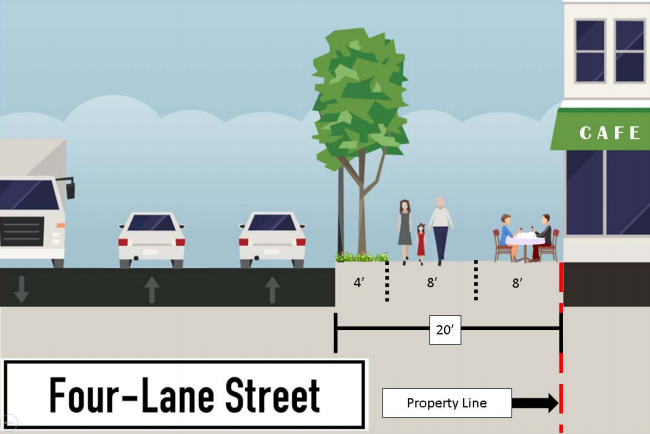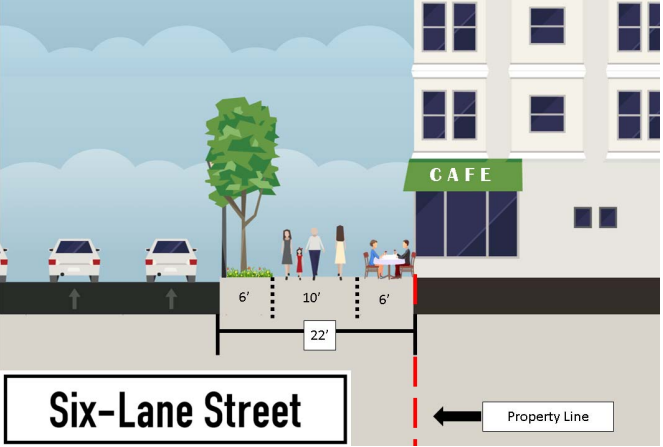In January 2017, the Houston Planning Commission launched the Walkable Places Project in order to promote walkable development in the Bayou City. Now, more than a year later, the Walkable Places Committee is finalizing its proposals to give to the Houston City Council by early 2019.
But any recommendations will have to contend with the city's current stubbornly unfriendly pedestrian landscape and a lack of funding.
The committee plans to present a two-part proposal to city council in early 2019. The first portion of the proposal is the general guiding ordinance to create a walkable place district either through an application or by being identified by the city as a walkable place, said Dipti Mathur, the Walkable Places planning manager. The boundaries and rules regarding development in a new walkable place would vary and be defined by the community submitting the application to the city.
The proposal also includes three pilot areas that would have to be approved by the city council, with guidelines for developers to follow. The committee is looking to target three pilot areas: Midtown, Emancipation Avenue and Near Northside.
Some of the elements that go into making a walkable place include buildings pulled closer to the street line, pedestrian-friendly building elements, wider sidewalks and parking placed behind the building, according to Muxian Fang, project manager of the Walkable Places Project. She continued to say that the current building codes were established in the 1980s and need to be updated as soon as possible.
"At that time, building ordinances were auto-centric," she said. "So it has been 30 years and we see that the trend has changed and we think that it is important to have different guidance and guide the development to be more walkable and hopefully, in turn, it will encourage people to come back and to take more public transit."
The committee looked at other cities with better walkability, according to Fang, but the relative lack of zoning in Houston is the major difference between their successes and Houston, saying in part, "We can not just copy what other cities - like Atlanta, Charlotte, Denver and even Austin - are doing because of zoning. We have to learn what they do and then develop an appropriate approach for what Houston needs to do."
Fang said that the pilot areas were targeted as beginning starting points for the walkability project because the areas had the best combination of factors, including development interest, transportation proximity and community interest. After they identified their focus areas, the committee reached out to the area's community through a series of meetings about the neighborhood's walkability.
The reception has been good, Fung said. "They think this is a great idea, but the challenge that we can see is that they are not familiar with the ordinance since this is a brand-new concept. So we have to take some time to explain to them exactly what this is and how will it affect their lives. Once this is clear, then they really welcome this concept."
The specific rules haven't yet been finalized since each area is different, but the Walkable Places Project leaders have a few ideas of development characteristics they'd like to see implemented within a flexible framework. Fang said, "We think every area should have a different rule - it should be context-specific."
"The intent of the ordinance is to encourage more walkable development and promote multimodal transportation to address the growing trend in the city. The ordinance will focus on guiding the forms of future development [and] redevelopment, such as pedestrian realm design, building and site design," Fang said through email. "One of the expected challenges is to change the developers’ mindset to develop pedestrian-oriented development, instead of automobile-oriented development."
Some possible design elements are shown in the graphics below.

The Walkable Places Committee may propose a minimum 15 foot-wide pedestrian area for a two-lane street to the City Council for new developments in pilot areas. Photo: City of Houston Walkable Places Committee

The Walkable Places Committee may propose a minimum 20 foot-wide pedestrian area for a four-lane street to the City Council for new developments in pilot areas. Photo: City of Houston Walkable Places Committee

The Walkable Places Committee may propose a minimum 22 foot-wide pedestrian area for a six-lane street to the City Council for new developments in pilot areas. Photo: City of Houston Walkable Places Committee
"Safety is definitely one of the important factors of walkable places," Fang said. "We would emphasize safety elements, because as we know a lot of the sidewalks may be really bad because it is really narrow or the condition is bad or the sidewalk is right next to the curb."
Once a Walkable Place is registered and approved through the city, the committee plans to have guides set in place for future developers to follow if they were to build or renovate in the walkable area.
If passed by city council, said Fang, "the ordinance will require all properties within the designated Walkable Place District comply with the adopted rules within the district." If a developer says they can't comply with the rules, they would only be permitted to bend the rule if they prove they have an "undue hardship," which will be reviewed and possibly approved or denied by the Planning Commission, according to Fang.
The committee won't be presenting its proposals to the city council until early 2019, but if implemented, the application to become a walkable place in Houston will be open to all areas throughout the city. If desired, any Houston neighborhood could be registered as a walkable place and future development would be encouraged to follow the guidelines set by the community pending city council approval.
Areas like East Downtown, which has experienced new transit and development in recent years, for example, could be ideal candidates. Indeed, Fang said East Downtown just missed a spot as a pilot area.
"When we were coming up with these matrices, we wanted different areas with different street grids. Midtown and Emancipation were very close-grid. Near Northside was totally different," Mathur said. "So a goal of ours was to understand what kind of curveballs we could be looking at with creating district criteria, we need different areas, so we could see how each area achieves and becomes a walkable place. East Downtown - grid wise - would have been too similar to Midtown and Emancipation."
Fang and her team recognize the process is going to be a slow one, but with every new development and building that goes up in a Walkable Place neighborhood, the hope is that it will transform, piece by piece, into a more pedestrian-friendly area.

